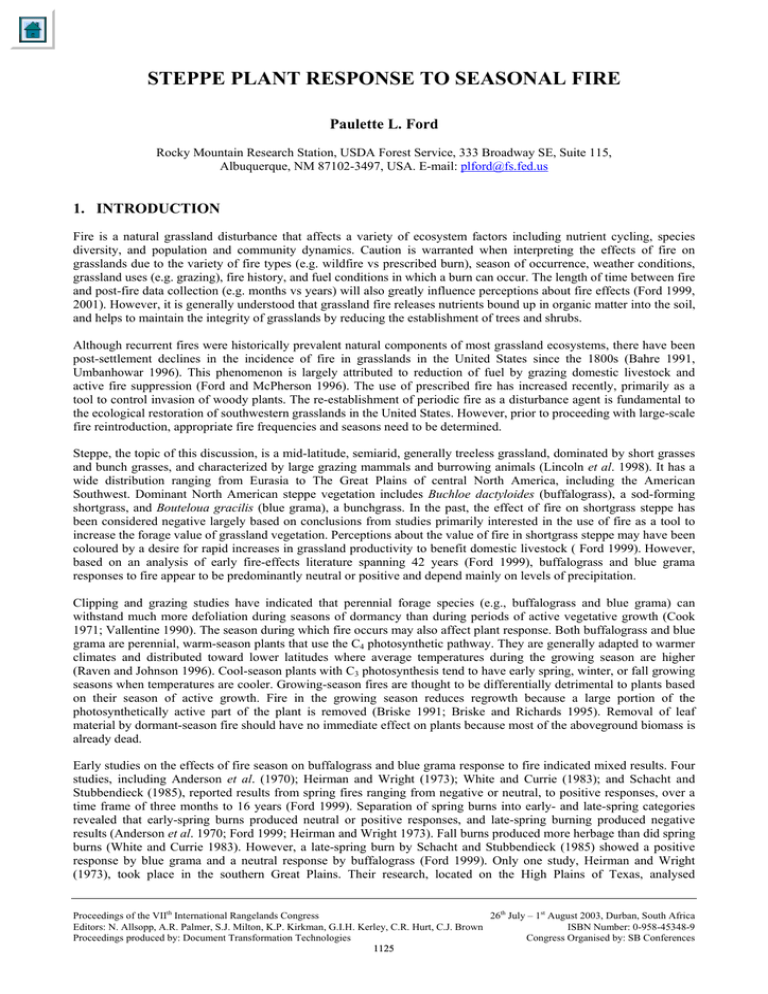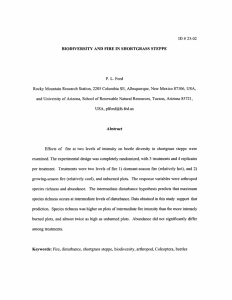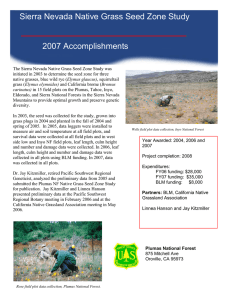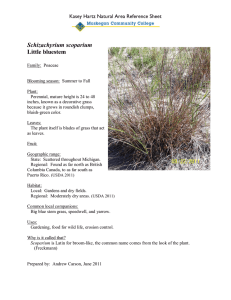STEPPE PLANT RESPONSE TO SEASONAL FIRE Paulette L. Ford
advertisement

STEPPE PLANT RESPONSE TO SEASONAL FIRE Paulette L. Ford Rocky Mountain Research Station, USDA Forest Service, 333 Broadway SE, Suite 115, Albuquerque, NM 87102-3497, USA. E-mail: plford@fs.fed.us 1. INTRODUCTION Fire is a natural grassland disturbance that affects a variety of ecosystem factors including nutrient cycling, species diversity, and population and community dynamics. Caution is warranted when interpreting the effects of fire on grasslands due to the variety of fire types (e.g. wildfire vs prescribed burn), season of occurrence, weather conditions, grassland uses (e.g. grazing), fire history, and fuel conditions in which a burn can occur. The length of time between fire and post-fire data collection (e.g. months vs years) will also greatly influence perceptions about fire effects (Ford 1999, 2001). However, it is generally understood that grassland fire releases nutrients bound up in organic matter into the soil, and helps to maintain the integrity of grasslands by reducing the establishment of trees and shrubs. Although recurrent fires were historically prevalent natural components of most grassland ecosystems, there have been post-settlement declines in the incidence of fire in grasslands in the United States since the 1800s (Bahre 1991, Umbanhowar 1996). This phenomenon is largely attributed to reduction of fuel by grazing domestic livestock and active fire suppression (Ford and McPherson 1996). The use of prescribed fire has increased recently, primarily as a tool to control invasion of woody plants. The re-establishment of periodic fire as a disturbance agent is fundamental to the ecological restoration of southwestern grasslands in the United States. However, prior to proceeding with large-scale fire reintroduction, appropriate fire frequencies and seasons need to be determined. Steppe, the topic of this discussion, is a mid-latitude, semiarid, generally treeless grassland, dominated by short grasses and bunch grasses, and characterized by large grazing mammals and burrowing animals (Lincoln et al. 1998). It has a wide distribution ranging from Eurasia to The Great Plains of central North America, including the American Southwest. Dominant North American steppe vegetation includes Buchloe dactyloides (buffalograss), a sod-forming shortgrass, and Bouteloua gracilis (blue grama), a bunchgrass. In the past, the effect of fire on shortgrass steppe has been considered negative largely based on conclusions from studies primarily interested in the use of fire as a tool to increase the forage value of grassland vegetation. Perceptions about the value of fire in shortgrass steppe may have been coloured by a desire for rapid increases in grassland productivity to benefit domestic livestock ( Ford 1999). However, based on an analysis of early fire-effects literature spanning 42 years (Ford 1999), buffalograss and blue grama responses to fire appear to be predominantly neutral or positive and depend mainly on levels of precipitation. Clipping and grazing studies have indicated that perennial forage species (e.g., buffalograss and blue grama) can withstand much more defoliation during seasons of dormancy than during periods of active vegetative growth (Cook 1971; Vallentine 1990). The season during which fire occurs may also affect plant response. Both buffalograss and blue grama are perennial, warm-season plants that use the C4 photosynthetic pathway. They are generally adapted to warmer climates and distributed toward lower latitudes where average temperatures during the growing season are higher (Raven and Johnson 1996). Cool-season plants with C3 photosynthesis tend to have early spring, winter, or fall growing seasons when temperatures are cooler. Growing-season fires are thought to be differentially detrimental to plants based on their season of active growth. Fire in the growing season reduces regrowth because a large portion of the photosynthetically active part of the plant is removed (Briske 1991; Briske and Richards 1995). Removal of leaf material by dormant-season fire should have no immediate effect on plants because most of the aboveground biomass is already dead. Early studies on the effects of fire season on buffalograss and blue grama response to fire indicated mixed results. Four studies, including Anderson et al. (1970); Heirman and Wright (1973); White and Currie (1983); and Schacht and Stubbendieck (1985), reported results from spring fires ranging from negative or neutral, to positive responses, over a time frame of three months to 16 years (Ford 1999). Separation of spring burns into early- and late-spring categories revealed that early-spring burns produced neutral or positive responses, and late-spring burning produced negative results (Anderson et al. 1970; Ford 1999; Heirman and Wright 1973). Fall burns produced more herbage than did spring burns (White and Currie 1983). However, a late-spring burn by Schacht and Stubbendieck (1985) showed a positive response by blue grama and a neutral response by buffalograss (Ford 1999). Only one study, Heirman and Wright (1973), took place in the southern Great Plains. Their research, located on the High Plains of Texas, analysed Proceedings of the VIIth International Rangelands Congress 26th July – 1st August 2003, Durban, South Africa Editors: N. Allsopp, A.R. Palmer, S.J. Milton, K.P. Kirkman, G.I.H. Kerley, C.R. Hurt, C.J. Brown ISBN Number: 0-958-45348-9 Proceedings produced by: Document Transformation Technologies Congress Organised by: SB Conferences 1125 buffalograss response 3-6 months after a spring fire. Long-term research is needed to clarify buffalograss and blue grama response to fire season in the southern Great Plains. In 1996 I began experimentally examining the response of North American shortgrass steppe to dormant-season versus growing-season fire and frequency of fire. This research, located in the southern Great Plains on the Kiowa National Grassland in northeastern New Mexico, examines the short- and long-term effects of fire frequency and seasonality on various ecosystem processes, including plant community composition, structure, diversity, productivity, nutrient cycling dynamics, and effects on biological soil crusts, arthropods, and small mammals. Treatments are composed of a combination of dormant- or growing-season fires and fire return intervals of 3, 6, or 9 years, and unburned. Replicates were randomly assigned to 35 2-ha plots. Experimental fire treatments were first applied to the site during the spring and summer of 1997, and will be applied periodically at intervals of 3, 6, and 9 years over 18 years. Brockway et al. (2002), reported from the first year’s results of this research that dormant-season fire may be the preferable method for restoring fire in shortgrass steppe ecosystems where fire has been excluded for a prolonged period of time. I discuss here the response of grass cover to season of fire, five years post-treatment. 2. STUDY AREA 2.1 Soil and Vegetation The study site is in shortgrass steppe of the southern Great Plains on the Kiowa National Grassland (36º 31' 20" N, 103º 3' 30"W) of the Cibola National Forest in Union County, New Mexico, USA. The southern Great Plains includes the eastern third of New Mexico, the northern two-thirds of Texas, and most of Oklahoma (Wright and Bailey 1982). Almost all of the grassland on the plains in this region is composed of mixed or shortgrass communities (Brown 1994). These communities have been considerably altered by grazing and the indirect effects of fire suppression followed by shrub invasion. However, much of the landscape still remains dominated by perennial grasses (Brown 1994). Shortgrass steppe (plains grassland) is the most extensive grassland in New Mexico, making up approximately 50% of the state’s grassland vegetation (Dick-Peddie 1993). My study site, located in the far northeast corner of New Mexico, still contains most of its native vegetation. Out of 99 plant species identified, only three are introduced (Table 1). The site consists of approximately 160 ha of shortgrass steppe that has never been ploughed, although it was grazed by livestock until 1990. The site is relatively homogenous and nearly flat. Elevation ranges from 1 455 m at the southwest corner to 1 472 m at the northwest corner of the site. Mean annual precipitation is 391 mm, classifying the site as a semi-arid grassland (Lincoln et al. 1998). The majority of precipitation occurs from May through September, with peak rainfall in July. Annual precipitation on the study site was above average for 1997 and 1999, with 609 mm, and 660 mm respectively; and near average for 1998, with 387 mm. 2002 was a drought year for much of the United States, when slightly more than 50% of the country experienced moderate to severe drought conditions during the summer months. Precipitation at the study site in 2002 was 69% of normal with a mean of 270 mm. The soils consist of approximately 5% Dioxice loam (Aridic Calciustolls), 25% Gruver loam (Aridic Paleustolls), 25% Sherm clay loam (Torretic Paleustolls), and 35% Spurlock loam (Ustollic Calciorthids) (Maxwell et al. 1981). Most of the soil mapping units contain pockets of other soil types resulting in a mosaic. The deep, well-drained loam soils support an almost shrubless grassland with a relatively tight sod of Buchloe dactyloides (Nutt.) Engelm and Bouteloua gracilis (H.B.K.) Lag. These two species account for 85% of the plant cover throughout the site. Depending on the location on the site, Hilaria jamesii (Torr.) Benth. ranges from 0 to 12% ground cover; Elymus elymoides (Raf.) Swezey 0 to 8%; and Bouteloua curtipendula (Michx.) Torr. 0 to 5% (Maxwell et al. 1981). Grass fine fuel was estimated to be 1 125 kg/ha (Paulette L. Ford, unpublished data). 1126 Table 1. Plant list (Family, Species and common name). * Indicates introduced species. AGAVACEAE, Agave Family Yucca glauca, small soapweed yucca ASCLEPIADACEAE, Milkweed Family Asclepias engelmannii, Engelmann milkweed Asclepias latifolia, broadleaf milkweed Asclepias pumila, plains milkweed ASTERACEAE (COMPOSITAE) Sunflower Family Ambrosia psilostachya, western ragweed Artemisia ludoviciana, Louisiana wormwood Berlandiera lyrata, chocolate flower Brickellia eupatorioides, false boneset Chaetopappa ericoides, rose heath Chrysothamnus parryi, rabbitbrush Cirsium ochrocentrum, yellowspine thistle Conyza canadensis, Canadian horseweed Dyssodia papposa, fetid marigold Engelmannia pinnatifida, Engelmann daisy Erigeron flagellaris, trailing fleabane Grindelia nuda,curlytop gumweed Gutierrezia sarothrae, broom snakeweed Helianthus annuus, common sunflower Heterotheca villosa, hairy goldenaster Hymenopappus sp., white ragweed Lactuca sp., lettuce Liatris punctata, dotted gayfeather Lygodesmia juncea, rush skeletonweed Machaeranthera pinnatifida, lacy tansyaster Machaeranthera tanacetifolia, tansyleaf aster Ratibida columnifera, upright prairie coneflower Ratibida tagetes, shortray prairie coneflower Senecio riddellii, Riddell ragwort Senecio neomexicanus, New Mexico groundsel Stephanomeria pauciflora, brownplume wirelettuce Tetraneuris scaposa, yellow daisy Thelesperma megapotamicum, Indian tea *Tragopogon sp., salsify Vernonia marginata, Plains ironweed Zinnia grandiflora, Rocky Mountain zinnia BORAGINACEAE, Borage Family Cryptantha sp., catseye BRASSICACEAE (CRUCIFERAE), Mustard Family Descurainia sp., tansy mustard Erysimum asperum, Plains wallflower CACTACEAE, Cactus Family Echinocereus viridiflorus, hedgehog cactus Opuntia imbricata, walkingstick or tree cholla Opuntia phaeacantha, brownspine prickly pear Opuntia polyacantha, Plains prickly pear CHENOPODIACEAE, Goosefoot Family Chenopodium berlandieri, pitseed goosefoot Chenopodium incanum, mealy goosefoot Chenopodium pratericola, desert goosefoot Kochia scoparia, fireweed Salsola kali, Russian thistle, tumbleweed CONVOLVULACEAE, Morning glory Family Evolvulus nuttallianus, shaggy dwarf morning-glory Ipomoea leptophylla, bush morning-glory CUCURBITACEAE, Gourd or Cucumber Family Curcurbita foetidissima, buffalo or coyote gourd EUPHORBIACEAE, Spurge Family Argythamnia mercurialina, silverbush Chamaesyce fendleri, Fendler sandmat Chamaesyce lata, hoary sandmat Euphorbia marginata, snow on the mountain FABACEAE (LEGUMINOSAE), Pea or Bean Family Astragalus missouriensis, Missouri milkvetch Astragalus mollissimus, woolly milkvetch Caesalpinia jamesii *Melilotus officinalis, yellow sweetclover Psoralidium tenuiflorum, wild alfalfa Sophora nuttalliana, silky sophora LOASACEAE, Loasa or Blazing-star Family Mentzelia nuda, bractless blazingstar Mentzelia reverchonii, blazingstar MALVACEAE, Mallow Family Spheralcea coccinea, scarlet globemallow NYCTAGINACEAE, Four-o’clock Family Mirabilis linearis, narrowleaf four o’clock ONAGRACEAE, Evening Primrose Family Gaura coccinea, scarlet gaura PLANTAGINACEAE, Plantain Family Plantago patagonica, woolly plantain POACEAE (GRAMINAE), Grass Family Andropogon gerardii, big bluestem Aristida adscensionis, six-weeks three-awn Aristida purpurea, Fendler three-awn Aristida purpurea, red three-awn Aristida havardii, Harvard three-awn Bothriochloa laguroides, beardgrass or bluestem Bouteloua curtipendula, sideoats grama Bouteloua gracilis, blue grama Bouteloua hirsuta, hairy grama *Bromus japonicus, Japanese brome Buchloe dactyloides, buffalograss Chloris verticillata, tumble windmillgrass Elymus elymoides, longleaf squirreltail Erioneuron pilosum, hairy wooly grass, hairy tridens Hilaria jamesii, galleta Muhlenbergia arenicola, sand muhly Muhlenbergia torreyi, ring muhly Monroa squarrosa, false buffalograss Panicum capillare, witchgrass Panicum halli, Hall panicgrass Panicum obtusum, vine mesquite Pasocopyrum smithii, Schedonnardus paniculatus, tumblegrass Schizachyrium scoparium, little bluestem Sporobolus cryptandrus, sand dropseed Stipa sp., needlegras POLYGONACEAE, Buckwheat or Knotweed Family Eriogonum annuum, annual buckwheat PORTULACACEAE, Purslane Family Portulaca sp., purslane SCROPHULARIACEAE, Figwort Family Penstemon sp., beardtongue SOLANACEAE, Nightshade or Potato Family Physalis hederifolia,, ivyleaf groundcherry Solanum elaeagnifolium, silverleaf nightshade Solanum rostratum, buffalobur nightshade VERBENACEAE, Vervain Family Glandularia (Verbena) bipinnatifida, mock vervain 1127 3. METHODS The experimental design for this portion of the study was completely randomised, with three treatments and four replicates per treatment. Treatments were (1) dormant-season fire in April 1997, (2) growing-season fire in July 1997, and (3) unburned. Treatments were randomly assigned to 12 2-ha plots. Plots were 140 m x 140 m with at least 60 m of unburned area between plots. Treatments were applied with drip torches by burning “black lines” around the inside perimeter of each burn plot. The interior of each plot was then burned using a strip headfire. Winds were gusting at approximately 9-18 km per hour when treatments were applied for both fire seasons. Dormant-season fire maximum flame height was 6-8 m in the centre of the plots, and each plot took approximately 15 minutes to burn completely. Growing-season fire maximum flame height was estimated at about 2 m, and plots took an average of 30-40 minutes to burn. Response variables measured were percent ground cover of grass, shrubs, forbs, cactus, biological soil crusts, litter, and bare ground. Sampling sessions were divided into six time periods. Period 1 = pre-treatment, March 1997. Period 2 = post dormant-season fire, April-June 1997. Period 3 = post growing-season fire, July-October 1997. Period 4 = late June/July-October 1998. Period 5 = October 1999. Period 6 = July 2002. Ground cover was measured once per month during all six sampling periods with one, 100-m, 500-point, basal area line-point transect per plot (a point was dropped every 20 cm). Permutation methods in SAS PROC MULTTEST (SAS Institute Inc. 1988, 1989-1996) were used for sets of three pairwise comparisons among treatments (unburned, dormant-season burn and growing-season burn) to analyse grass cover from 1997-2002. All comparisons were considered significant at P = 0.05. 4. RESULTS Grass cover did not significantly differ on the experimental plots before treatment (Figure 1, Period 1). Grass cover averaged around 63% for all 12 plots. Immediately after both fire treatments were applied (April 1997 and July 1997), grass cover was significantly reduced on both treatments (Period 2 and Period 3). However, data presented by Ford (2001) shows that by Period 3, approximately three months later, grass cover on plots burned in the dormant season did not significantly differ from unburned plots. Furthermore, there still were no significant differences in grass cover between unburned plots and plots burned in the dormant season 1 to 2.5 years later (Figure 1, Periods 4 and 5). In contrast, growing-season fire significantly reduced grass cover compared to unburned plots for up to 15 months after fire (Figure 1, Period 4), though there was no significant difference between dormant- vs growing-season fire grass cover. In 1999, approximately 2.5 years after the first fire treatments were applied, there were no significant differences in grass cover among treatments (Figure 1, Period 5) (Ford 2001). Approximately five years after the fire treatments were applied there were still no significant differences in grass cover between unburned and dormant-season fire treatments (Figure 1, Period 6). There were also still no significant differences between dormant-season and growing-season fire treatments. However, grass cover did significantly differ between unburned and growing-season fire plots, with grass cover significantly lower on unburned plots (0 = 33%) than growing-season fire plots (0 = 46%). Mean grass cover on dormant-season fire plots was 43%. 5. DISCUSSION Results from this research indicate that fire is important in maintaining the integrity of shortgrass steppe. However, interpretations about fire effects will differ based on short-term versus long-term data. For example, there was no difference in grass cover between unburned plots and plots burned in the dormant season from three months to five years after fire treatment. In contrast, plots burned in the growing season took about 2.5 years to recover. Five years later, during a drought period, grass cover was reduced by at least 20% on all experimental plots, regardless of treatment. However, growing-season fire grass cover exceeded that of both dormant-season fire and unburned plots. Dormant-season fire response from this research was consistent with the majority of studies on fire response of buffalograss and blue grama, indicating a predominately neutral or positive response to fire. However, given enough time, plants also recovered from growing-season fire with grass cover that while not statistically higher than dormantseason fire grass cover, was also not lower, as expected. Clearly the mechanisms driving this response, whether nutrient cycling, shifts in species composition, or a combination of both, deserve further analysis. 1128 Period 2 = after dormant season fire Period 3 = after growing season fire Period 4 = approximately 1 year later Period 5 = approximately 2 years later Period 6 = approximately 5 years later Within period, different letters indicate significant difference (α = .05) Figure 1. Percent Grass Ground Cover Period 1 = pretreatment 6. DISCUSSION Results from this research indicate that fire is important in maintaining the integrity of shortgrass steppe. However, interpretations about fire effects will differ based on short-term versus long-term data. For example, there was no difference in grass cover between unburned plots and plots burned in the dormant season from three months to five years after fire treatment. In contrast, plots burned in the growing season took about 2.5 years to recover. Five years later, during a drought period, grass cover was reduced by at least 20% on all experimental plots, regardless of treatment. However, growing-season fire grass cover exceeded that of both dormant-season fire and unburned plots. Dormant-season fire response from this research was consistent with the majority of studies on fire response of buffalograss and blue grama, indicating a predominately neutral or positive response to fire. However, given enough time, plants also recovered from growing-season fire with grass cover that while not statistically higher than dormantseason fire grass cover, was also not lower, as expected. Clearly the mechanisms driving this response, whether nutrient cycling, shifts in species composition, or a combination of both, deserve further analysis. 1129 Basal cover is only one response variable that can be used to measure fire effects on grassland vegetation. Other commonly used variables include plant productivity (herbage yield), seedstalk counts, nutrient status, species composition, and soil chemistry. Brockway et. al. (2002) reported that in the short term dormant-season fire (applied to the site in April 1997) was followed by increases in grass cover, forb cover, species richness and concentrations of foliar P, K, Ca, Mg and Mn. Growing-season fire (applied to the site in July 1997) was followed by declines in the cover of buffalograss, graminoids and forbs, and increases in litter cover and levels of foliar P, K, Ca, and Mn. Although no changes in soil chemistry were observed, both fire treatments caused decreases in herbaceous production, with standing biomass resulting from growing-season fire approximately 600 kg/ha, and dormant-season fire approximately 1,200 kg/ha, compared with unburned plots averaging approximately 1,800 kg/ha. A comparison of an additional five years of grass cover data alone demonstrates that long-term data are needed to accurately assess the effect of fire on ecosystems. Post-treatment measurements by Brockway et al. (2002) were completed six months after fire treatment (August and September 1997) on plots burned during the dormant season, and five months after fire treatment (October and November 1997) on plots burned during the growing season. Based on grass cover six months after fire, I would not have predicted higher grass cover on growing-season fire plots five years later during a drought. In 2003, complete plant cover, productivity, nutrient status, species composition, and soil chemistry data will be collected again from the study site. Data from this collection cycle will address not only the effect of fire season, but also the effect of the frequency of fire on shortgrass steppe. 7. ACKNOWLEDGEMENTS Many thanks to Rudy King, Carol Raish, Michele Merola Zwartjes, Burton and Rosemary Pendleton, and Sandra Brantley for comments and reviews. 8. REFERENCES Anderson KL, Smith EF and Owensby CE 1970. Burning bluestem range. Journal of Range Management 23:81-92. Bahre CJ 1991. A legacy of change: historic impact on vegetation in the Arizona borderlands. University of Arizona Press, Tucson. Briske DD 1991. Developmental morphology and physiology of grasses. In: Heitschmidt and Stuth (eds.). Grazing Management: An Ecological Perspective. Timber Press, Portland, OR. Briske DD and Richards JH 1995. Plant responses to defoliation: a physiological, morphological, and demographic evaluation. In: Bedunah and Sosebee (eds.). Wildland Plants: Physiological Ecology and Developmental Morphology. Society for Range Management, Denver, CO. Brockway DG, Gatewood RG and Paris RB 2002. Restoring fire as an ecological process in shortgrass prairie ecosystems: initial effects of prescribed burning during the dormant and growing seasons. Journal of Environmental Management 65:135-152. Brown DE 1994. Biotic communities: southwestern United States and northwestern Mexico. University of Utah Press, Salt Lake City. Cook CW 1971. Effects of Season and Intensity of Use on Desert Vegetation. Utah Agricultural Experiment Station Bulletin 483. Dick-Peddie WA 1993. New Mexico vegetation, past, present, and future. University of New Mexico Press. Ford PL 1999. Response of buffalograss (Buchloe dactyloides) and blue grama (Bouteloua gracilis) to fire. Great Plains Research 9:261-276. Ford PL 2001. Scale, ecosystem resilience, and fire in shortgrass steppe of the southern Great Plains. In: Brebbia CA, Villacampa Y and Uso JL (eds.). Ecosystems and Sustainable Development III. Series: Advances in Ecological Sciences, Vol 10. WITPress Southampton, Boston. Ford PL and McPherson GR 1996. Ecology of fire in shortgrass prairie of the southern Great Plains. In: Finch DM (ed.). Ecosystem disturbance and wildlife conservation in western grasslands: a symposium proceedings. USDA Forest Service, Rocky Mountain Forest and Range Experiment Station, General Technical Report RM-GTR-285. Fort Collins, CO. Heirman AL and Wright HA 1973. Fire in medium fuels of west Texas. Journal of Range Management 26:331-335. Lincoln R, Boxshall G and Clark P 1998. Dictionary of Ecology, Evolution and Systematics. Second Edition, Cambridge University Press. 1130 Maxwell HB, Shade SP, Rounsaville HD and Stevenson A 1981. Soil survey of Union County, New Mexico. USDA Soil Conservation Service and Forest Service. Raven PH. and Johnson GB 1996. Biology, 4th ed. Wm.C. Brown Publishers, Dubuque, IA. SAS Institute Inc. 1988. SAS/STAT User’s Guide, Release 6.03 Edition. SAS Institute Inc, Cary, NC. SAS Institute Inc. 1989-1996. The SAS System for Windows Release 6.12. SAS Institute Inc, Cary, NC. Schacht W and Stubbendieck J 1985. Prescribed burning in the Loess Hills mixed prairie of southern Nebraska. Journal of Range Management 38:47-51. Umbanhowar CE 1996. Recent fire history of the northern Great Plains. American Midland Naturalist 1335:115-121. Vallentine JF 1990. Grazing Management. Academic Press, San Diego. White RS and Currie PO 1983. Prescribed burning in the northern Great Plains: Yield and cover responses of 3 forage species in the mixed grass prairie. Journal of Range Management 36:179-183. Wright HA and Bailey AW 1982. Fire Ecology—United States and southern Canada. John Wiley and Sons, New York. 1131





